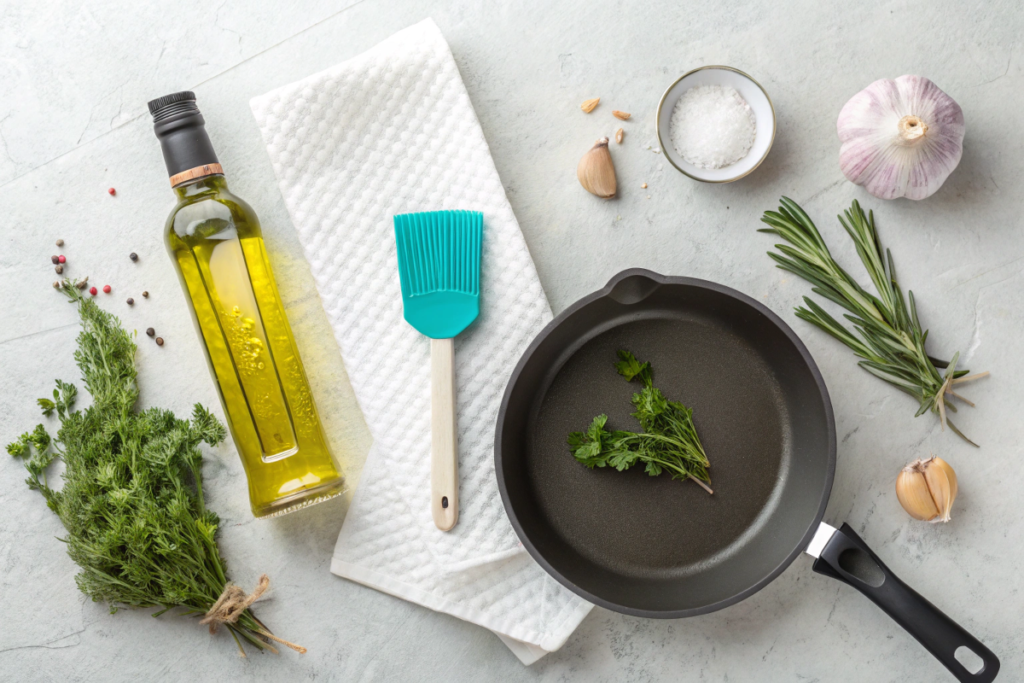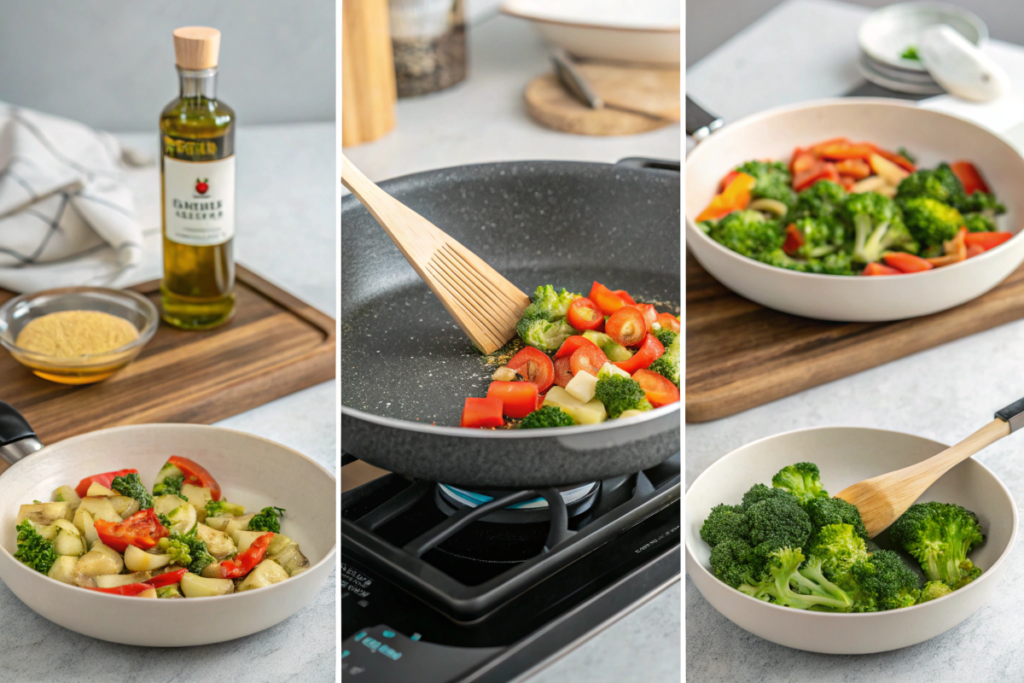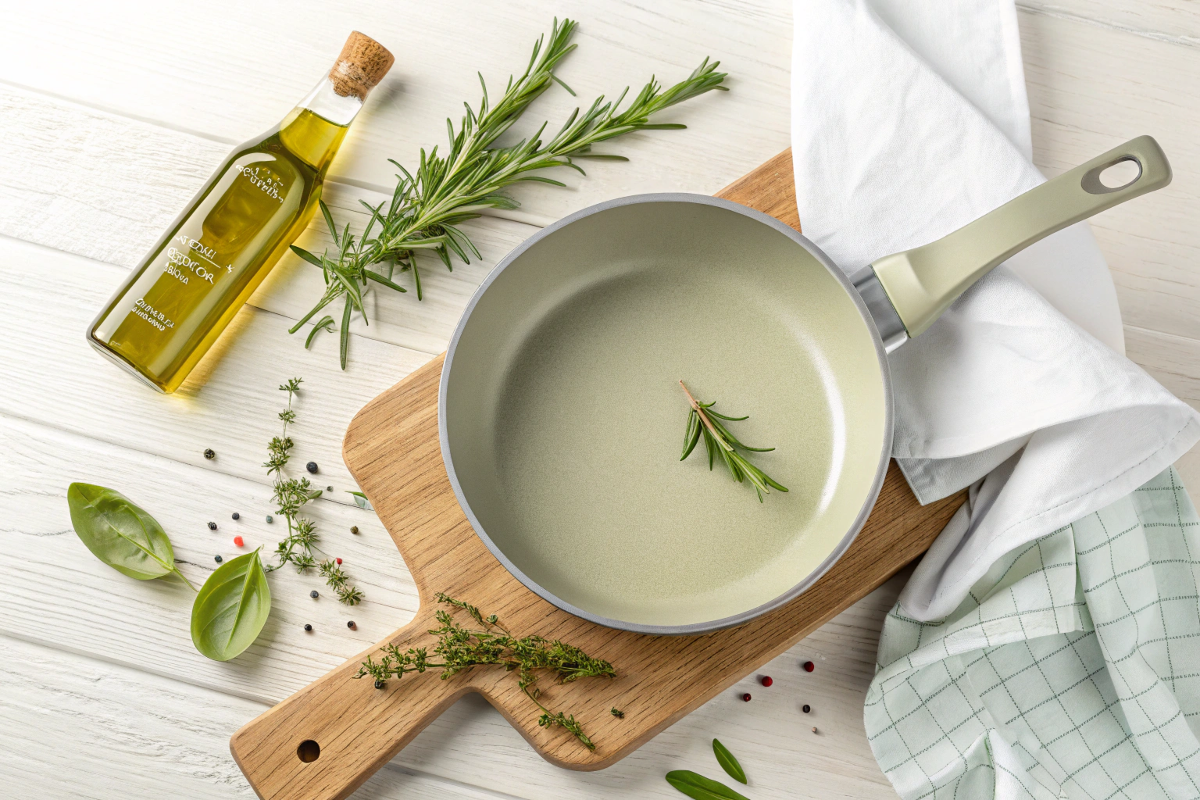Cooking with the right oils and cookware is essential for creating delicious and healthy meals. Caraway pans have gained popularity for their non-stick ceramic coating and stylish design. However, many home cooks wonder: Can you use olive oil in Caraway pans?
This guide explores the compatibility of olive oil with Caraway cookware, offering practical tips, benefits, potential risks, and alternative options to enhance your cooking experience. If you want more insights, check out The Ultimate Guide to Caraway Air Fryer.
What Are Caraway Pans Made Of?
Materials, Coatings, and Design Benefits
Caraway pans are renowned for their high-quality construction and aesthetic appeal. These pans typically feature:
- Ceramic Non-Stick Coating: The ceramic coating provides a smooth, non-stick surface that requires less oil for cooking, making meals healthier.
- Aluminum Core: An aluminum core ensures even heat distribution, preventing hot spots and ensuring consistent cooking results.
- Stainless Steel Handles: Durable and heat-resistant handles offer a comfortable grip and remain cool during cooking.
- Stylish Design: Available in various colors and sleek designs, Caraway pans complement modern kitchen décors.
The combination of these materials and coatings makes Caraway pans versatile and efficient for a wide range of cooking tasks, from sautéing vegetables to frying proteins.
Why Olive Oil Is a Popular Cooking Choice
Health Benefits, Flavor Profile, and Versatility
Olive oil is a staple in many kitchens worldwide, prized for its numerous benefits:
- Health Benefits: Rich in monounsaturated fats and antioxidants, olive oil supports heart health and reduces inflammation.
- Flavor Profile: Offers a distinct, fruity flavor that enhances the taste of various dishes without overpowering other ingredients.
- Versatility: Suitable for a wide range of cooking methods, including sautéing, roasting, and dressing salads.
These attributes make olive oil a favored choice among health-conscious individuals and culinary enthusiasts alike.
Can You Use Olive Oil in Caraway Pans?
A Detailed Answer with Practical Tips for Safe Use
Can you use olive oil in Caraway pans? Yes, you can, but with some considerations to ensure the longevity of your cookware and the quality of your meals. Here’s how to use olive oil safely and effectively in Caraway pans:
- Use Extra Virgin Olive Oil: Opt for extra virgin olive oil, which has a higher smoke point and richer flavor compared to lower-grade oils.
- Moderate Amounts: Use moderate amounts of olive oil to maintain the non-stick properties of the ceramic coating without causing buildup.
- Heat Control: Avoid overheating the pan. Cook on medium or medium-low heat to prevent the olive oil from reaching its smoke point.
- Proper Application: Spread the olive oil evenly across the cooking surface using a brush or a paper towel to ensure uniform coverage.
By following these tips, you can enjoy the benefits of olive oil while preserving the integrity of your Caraway pans.
Benefits of Using Olive Oil in Caraway Pans
Enhanced Flavors, Even Heat Distribution, and Non-Stick Advantages
Incorporating olive oil into your cooking with Caraway pans offers several benefits:
- Enhanced Flavors: Olive oil infuses dishes with a rich, fruity flavor that complements a variety of ingredients.
- Even Heat Distribution: The aluminum core of Caraway pans, combined with olive oil, ensures even cooking without hot spots.
- Non-Stick Advantages: Olive oil enhances the non-stick properties of ceramic coatings, allowing for easier food release and minimal sticking.
- Healthier Cooking: Using olive oil reduces the need for excessive fats, promoting healthier meal preparation.
These benefits make olive oil an excellent choice for cooking with Caraway pans, enhancing both the taste and nutritional value of your meals.

Potential Risks of Using Olive Oil in Caraway Pans
Smoke Point Concerns and Cleaning Challenges
While olive oil is generally safe to use, there are some potential risks to be aware of when cooking with Caraway pans:
- Smoke Point Concerns: Olive oil has a lower smoke point compared to some other oils. Overheating can cause it to smoke, potentially damaging the ceramic coating and producing unpleasant flavors.
- Cleaning Challenges: Residual olive oil can build up on the pan over time, requiring thorough cleaning to maintain the non-stick surface.
To mitigate these risks, monitor cooking temperatures closely and clean your Caraway pans promptly after use.
How to Safely Use Olive Oil in Caraway Pans
Best Practices for Cooking Temperatures and Oil Application
To maximize the benefits and minimize the risks of using olive oil in Caraway pans, follow these best practices:
- Preheat Properly: Allow the pan to preheat on medium heat before adding olive oil. This ensures even cooking and prevents sticking.
- Apply Oil Sparingly: Use just enough olive oil to coat the surface lightly. Excess oil can lead to buildup and affect the non-stick properties.
- Avoid High Heat: Cook on medium or medium-low heat to prevent the olive oil from reaching its smoke point, preserving both the oil and the pan’s coating.
- Use Utensils Wisely: Opt for wooden, silicone, or non-metal utensils to avoid scratching the ceramic surface while cooking.
By adhering to these practices, you can safely and effectively use olive oil in your Caraway pans, enhancing your cooking experience without compromising your cookware.
Cleaning and Maintaining Caraway Pans After Olive Oil Use
Proper Cleaning Techniques and Tips to Extend Lifespan
Maintaining your Caraway pans after using olive oil ensures their longevity and optimal performance. Here are some cleaning tips:
- Cool Down Naturally: Allow the pan to cool to room temperature before cleaning to prevent thermal shock, which can damage the ceramic coating.
- Use Mild Detergents: Clean the pan with warm water and a mild dish soap to remove olive oil residues without harming the non-stick surface.
- Avoid Abrasive Cleaners: Do not use steel wool or abrasive sponges, as they can scratch the ceramic coating. Instead, use soft sponges or cloths.
- Dry Thoroughly: After washing, dry the pan completely with a soft towel to prevent water spots and maintain the integrity of the ceramic coating.
- Regular Maintenance: Periodically season the pan with a light coat of olive oil to maintain its non-stick properties and prevent oil buildup.
Following these cleaning and maintenance practices helps extend the life of your Caraway pans and ensures they remain in excellent condition for years to come.

Alternative Oils for Caraway Pans
Comparison of Oils: Avocado, Coconut, Canola, and Grapeseed
If you’re looking to diversify your cooking oils or seek alternatives to olive oil, consider these options:
- Avocado Oil:
- Pros: High smoke point (around 520°F/271°C), neutral flavor, rich in monounsaturated fats.
- Cons: More expensive than some other oils.
- Coconut Oil:
- Pros: Adds a subtle coconut flavor, solid at room temperature for easy spreading.
- Cons: Lower smoke point (around 350°F/177°C) compared to avocado oil.
- Canola Oil:
- Pros: Neutral taste, high smoke point (around 400°F/204°C), affordable.
- Cons: Less flavorful, some concerns about GMO content.
- Grapeseed Oil:
- Pros: High smoke point (around 420°F/216°C), light flavor, rich in polyunsaturated fats.
- Cons: Can be pricey, less common in some regions.
Each of these oils offers unique benefits and can be used safely in Caraway pans when applied correctly, providing flexibility in your cooking routine.
Recipes Perfect for Olive Oil in Caraway Pans
Suggestions Like Sautéed Vegetables, Seared Proteins, and Pasta Dishes
Caraway pans paired with olive oil create a versatile cooking environment suitable for a wide range of recipes. Here are some ideas to inspire your culinary adventures:
- Sautéed Vegetables:
- Ingredients:
- 2 tablespoons olive oil
- 1 cup broccoli florets
- 1 cup sliced bell peppers
- 1/2 cup sliced carrots
- Salt and pepper to taste
- Directions:
- Heat olive oil in the Caraway pan over medium heat.
- Add broccoli, bell peppers, and carrots.
- Sauté for 5-7 minutes until vegetables are tender-crisp.
- Season with salt and pepper before serving.
- Ingredients:
- Seared Chicken Breast:
- Ingredients:
- 2 tablespoons olive oil
- 2 chicken breasts
- Salt, pepper, and your favorite herbs
- Directions:
- Preheat the Caraway pan on medium heat and add olive oil.
- Season chicken breasts with salt, pepper, and herbs.
- Sear the chicken for 6-7 minutes on each side until fully cooked.
- Let rest for a few minutes before serving.
- Ingredients:
- Pasta with Garlic and Olive Oil:
- Ingredients:
- 2 tablespoons olive oil
- 4 cloves garlic, minced
- 1/4 teaspoon red pepper flakes
- 8 ounces spaghetti
- Salt and parsley for garnish
- Directions:
- Cook spaghetti according to package instructions and set aside.
- Heat olive oil in the Caraway pan over medium heat.
- Add minced garlic and red pepper flakes, sautéing until fragrant.
- Toss cooked spaghetti in the garlic olive oil mixture.
- Season with salt and garnish with fresh parsley before serving.
- Ingredients:
These recipes demonstrate the versatility of using olive oil in Caraway pans, allowing you to create flavorful and healthy dishes with ease.
FAQs About Olive Oil and Caraway Pans
Can I use olive oil on ceramic cookware like Caraway pans?
Yes, olive oil is safe for use on ceramic cookware, including Caraway pans. It enhances the non-stick properties and adds flavor to your dishes when used correctly.
Is olive oil good for Caraway pans?
Absolutely. Olive oil is not only safe but also beneficial for cooking with Caraway pans. It helps in evenly distributing heat and prevents food from sticking.
Can olive oil damage Caraway pans?
When used in moderation and at appropriate temperatures, olive oil does not damage Caraway pans. However, overheating the oil can lead to smoke and potential damage to the ceramic coating.
What is the best olive oil for cooking in Caraway pans?
Extra virgin olive oil is ideal due to its higher smoke point and rich flavor. It provides the best balance of health benefits and culinary performance.
How do I prevent olive oil from smoking in Caraway pans?
To prevent smoking, cook on medium or medium-low heat and avoid leaving the pan unattended. Additionally, using high-quality extra virgin olive oil can help maintain a higher smoke point.
Comparing Olive Oil to Other Cooking Fats
Pros and Cons of Butter, Lard, and Other Cooking Fats
When selecting cooking fats for your Caraway pans, consider how olive oil stacks up against other options:
- Butter:
- Pros: Adds rich flavor and enhances browning.
- Cons: Lower smoke point, which can lead to burning and smoking at high temperatures.
- Lard:
- Pros: Excellent for frying due to high smoke point, adds a unique flavor to dishes.
- Cons: High in saturated fats and cholesterol, making it less heart-healthy.
- Vegetable Oil:
- Pros: Neutral flavor, high smoke point, affordable.
- Cons: Often contains unhealthy trans fats and lacks the health benefits of olive oil.
- Coconut Oil:
- Pros: Adds a subtle coconut flavor, high smoke point, rich in medium-chain triglycerides.
- Cons: Can impart a distinct flavor that may not suit all dishes, high in saturated fats.
Olive oil offers a balanced combination of flavor, health benefits, and cooking performance, making it a superior choice for many culinary applications in Caraway pans.
Environmental Benefits of Caraway Pans and Olive Oil
Sustainability Aspects of Both Products
Choosing eco-friendly cookware and cooking oils can contribute to a more sustainable lifestyle:
- Caraway Pans:
- Sustainable Manufacturing: Caraway emphasizes environmentally responsible manufacturing processes.
- Durability: Long-lasting cookware reduces the need for frequent replacements, minimizing waste.
- Olive Oil:
- Eco-Friendly Production: Olive oil production can be sustainable, especially when sourced from organic farms that prioritize environmental stewardship.
- Renewable Resource: Olive trees are a renewable resource that can thrive in various climates, supporting biodiversity and soil health.
By pairing Caraway pans with olive oil, you support sustainable practices and reduce your environmental footprint in the kitchen.
Troubleshooting Common Issues
What to Do If Food Sticks or Pans Discolor
Even with non-stick cookware and proper oil usage, you might encounter some issues. Here’s how to address common problems:
- Food Sticking:
- Solution: Ensure the pan is properly preheated and lightly oiled before adding food. Avoid overcrowding the pan, which can trap moisture and cause sticking.
- Pan Discoloration:
- Solution: Regularly clean your Caraway pans to prevent oil residue buildup. Use baking soda and water for stubborn stains without scratching the ceramic surface.
- Uneven Cooking:
- Solution: Distribute oil evenly and avoid using too much liquid. Monitor cooking temperatures and adjust as necessary to ensure even heat distribution.
Addressing these issues promptly helps maintain the performance and appearance of your Caraway pans.
Conclusion
Can you use olive oil in Caraway pans? Yes, you can, and doing so enhances both the cooking process and the flavors of your dishes. Olive oil is not only safe for Caraway cookware but also offers numerous benefits, including improved heat distribution, enhanced flavors, and health advantages. By following best practices—such as using the right type of olive oil, applying it sparingly, and maintaining proper cooking temperatures—you can enjoy the full potential of your Caraway pans without compromising their integrity.
Moreover, understanding the benefits and potential risks allows you to make informed decisions, ensuring that your cooking remains both delicious and sustainable. Whether you’re sautéing vegetables, searing proteins, or preparing pasta dishes, olive oil and Caraway pans make a perfect pair for creating healthy and flavorful meals.
Embrace the versatility of olive oil in your Caraway cookware, experiment with different recipes, and enjoy the ease and efficiency these tools bring to your kitchen. With proper use and care, your Caraway pans and olive oil will become indispensable components of your culinary toolkit, supporting a healthier and more enjoyable cooking experience.
Happy cooking!

